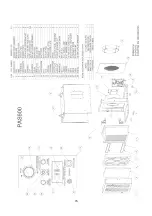
3
• Second stage. 2" deep, particulate pleated pre-filter (P/N: H502) is designed to capture particles 10
microns or larger.
• Final stage. HEPA filter (P/N: H161606-99) is tested & certified to capture at least 99.97% (9,997 out of
10,000) 0.3-micron particles.
Note:
The particulate filters included with this unit do not remove odors, vapors or gases, including volatile
organic compounds.
ALTERNATE FILTER (PURCHASED SEPARATELY)
VAPOR-LOCK® pleated, high-capacity, carbon filters (P/N: VL1002) are available for capturing OVG. These 2”-
deep filters can be used as an alternate second stage pre-filter to reduce airborne OVG by chemically bonding
the OVG molecules to the surface area of the carbon granules via a process known as adsorption. The VL1002
filters also provides a similar level of particulate filtration efficiency to the H502 pre-filters.
Effective carbon adsorption is dependent upon the amount of carbon & exposed carbon granule surfaces, and
the dwell (contact) time the OVG molecules have with the carbon granules. Operating the unit at lower speed
settings to increase dwell time can therefore improve OVG adsorption, though it is highly unlikely that all of the
OVG will be removed in one pass of air through the unit. Operating the unit in the recirculation mode can increase
effectiveness, by exposing OVG particles to multiple passes through the VAPOR-LOCK® filter.
It is almost impossible to provide accurate estimates to two commonly asked questions: “how much time will it
take to capture all of the OVG?”, and “how do I know when a carbon filter should be replaced?” Unfortunately,
unknown factors – such as concentration levels, fresh-air intake volume, temperature, and humidity – prevent
establishment of any more accurate ‘rule of thumb’ than one’s sense of smell. Since off-gassing of adsorbed
OVG can occur when the adsorption capacity of the filter is reached, replace the carbon filter as soon as odor
breakthrough is sensed. More detailed information on carbon adsorption can be found in an article titled:
“Activated Carbon: How Is It Used? How Does It Work?” which can be found on the Abatement Technologies
website,
www.abatement.com
.
DETERMINING THE REQUIRED NUMBER OF AIR FILTRATION DEVICES (AFD)
1. Calculate the total air volume (V) in cubic feet (ft³) within the enclosed containment area by multiplying
the length (L) x the width (W) x the height (H), all in feet (V = L x W x H).
2. Determine the minimum number of air changes per hour (ACH) specification. When no ACH number is
specified, most users target at least 6 ACH for construction areas. A good practice is to build in a safety
factor to compensate for filter loading, duct losses, reduced voltage, and other factors that can reduce
actual installed airflow. For example, if 6 ACH is the objective, enter 7.5 ACH for a 25% safety factor,
enter 9 ACH for a 50% safety factor, or enter 10.5 for a 75% safety factor.
3. Select an Abatement Technologies room air filtration device (AFD) model and determine the peak airflow
rating for that model in cubic feet per minute (CFM).
4. Determine the total number of AFD required using the following formula: Quantity = (V x Design ACH) /
(AFD Rating x 60)
5. Always round up to the next whole number. For example, if the total number of AFD required is 1.32, 2
units are recommended, not 1.
Example:
How many air filtration devices (each with 600 CFM rated airflow) would be required to provide 7.5
ACH (including a safety factor) in a 20’ x 36’ x 8’ containment area?
1. V = 20 ft x 36 ft x 8 ft = 5760 ft³
2. Design ACH = 7.5
3. Quantity of AFD required = (5760 ft³ x 7.5 ACH) / (600 CFM x 60) = 43200/36000 = 1.2 units
4. 1.2 units
→
2 units required.

































